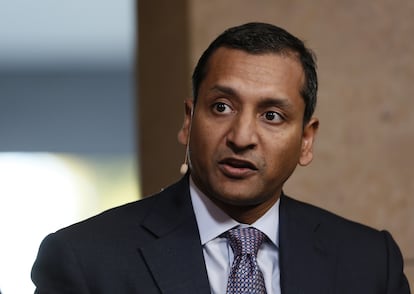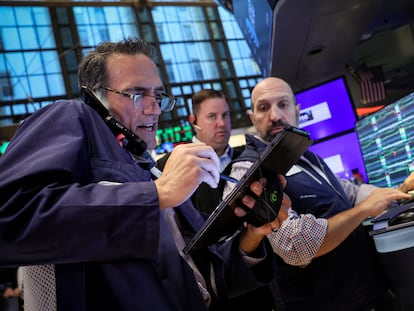Bobby Jain, the latest guest at the multibillion-dollar hedge fund party
The former manager of Credit Suisse and Millennium has created a multi-strategy firm that has raised $5.3 billion for its launch


Multi-strategy hedge funds have become the hottest investment vehicle on Wall Street. Amid the success of companies such as Citadel and Millennium, a wave of firms has sprung up seeking to emulate them. These firms are often launched by Citadel or Millennium alumni who wish to lead their own projects. The latest to do so was Bobby Jain, a former senior official at Millennium, who has raised $5.3 billion for his new multi-strategy fund. He is the latest important guest at the multibillion-dollar hedge fund party.
The world of hedge funds was a revolution in finance that made it possible to systematize all kinds of strategies, some already existing and others new. Unlike traditional investment funds, which — to put it simply — try to select a portfolio of quality assets that will appreciate in the long term, within their investment universe (fixed income, equities, sectors, geographical areas...), hedge funds have been looking for untapped approaches and opportunities. Some specialized in arbitrage (unjustified price differences), others in events (such as mergers, takeovers), others in short ladder attacks (against overvalued companies), some use advanced quantitative methods, others take more instinctive decisions, some created new ways of approaching derivatives, bond markets, stock market investment... And then there are the firms that do all this at the same time: multi-strategy hedge funds.
These firms centralize issues such as access to capital, risk management, macroeconomic analysis, the technological platform and other corporate functions, but have a great deal of flexibility, creating a kind of internal competition to see who comes up with the best investment strategies. Each team is responsible for investing with its strategy and in its market. Diversification reduces risk and makes it possible to achieve high returns even in adverse environments. In fact, this is when they show their full potential. Hedge funds have become an alternative to other forms of investment, such as private equity funds. One industry insider compares them to a general hospital, with some centralized functions, but with specialists in the different pathologies.
The dozens or hundreds of managers at a multi-strategy hedge fund do no get awarded based on the companies profits, but rather on the profitability of the portfolio they manage. If they do well, the group gives them more funds to manage. If they do it poorly, they are fired. The sector is governed by savage meritocracy and is marked by a war for talent, with enormous bonuses and incentives for successful managers.
Ken Griffin, the founder of Citadel, has become the 34th richest person in the world, with a fortune valued at $41.8 billion, according to the Bloomberg Billionaires Index, thanks to the firm he founded in 1990. Citadel is a multi-strategy hedge fund because it has macro units, stocks, raw materials, quantitative investment and then, within each of those areas, it is also multi-strategy, because it is organized in so-called pods, which each have their own mini strategy within that market.
Griffin is a pioneer in hiring mathematicians and introducing algorithm-based computer programs to predict market behavior. He pays fortunes to his successful employees and is spoiled for choice. “Our ability to recruit experienced professionals to Citadel is unparalleled,” he said in his latest letter to investors. “This year, for example, we received over 100,000 applications from undergraduate and graduate students for positions in our full-time and internship programs within the Citadel family. We will select a small fraction of one percent of these incredibly talented applicants, maintaining the exceptionally high standards we set for talent.”
The founder of Millennium, the other most successful multi-strategy hedge fund, is Izzy Englander, whose personal fortune is valued at $13.3 billion. While Citadel has a more hierarchical and uniform operation (within the internal competition between portfolio managers), Millennium has always been more decentralized, with the advantages and disadvantages that come with this. Someone in the industry compared it to an airport that rents fingers and check-in counters, but lets each operate in its own way.
Embarking on a new path
Bobby Jain is launching a new hedge fund after leaving Millennium. He worked for more than two decades at Credit Suisse, where he held various positions, including global head of asset management. At Millennium, he shared the position of Investment Director with Englander. During his seven years there, he helped the firm drive new strategies, hire staff, update technologies and develop its risk control system. During his time, Millennium’s assets doubled to $60 billion. But Jain — who is married with three children and lives with his family in Manhattan — felt the need to embark on his own path.
Jain Global is the biggest launch since ExodusPoint Capital Management, the hedge fund founded by Michael Gelband, another Millennium alumnus, which raised $8 billion for its launch in 2018.
Dieho Megía, also formerly from Millennium, has also launched Taula Capital Management, gathering $5 billion in commitments. While Gelband broke ties with his old job, Megía left Millennium on good terms and even received $3 billion from the company to manage in Taula. Megía was hired by Citadel in 2017 to create and lead a global public bond trading team. After two years at that firm, he joined Millennium in 2019.
Taula Capital Management focuses on macro, fixed-income relative value and inflation-risk trading. Although it has several strategies, it does not have the size, complexity and risk diversification of giants such as Citadel. It is as if a specialist had left the general hospital to found a clinic specializing in a specific pathology.
Bobby Jain has been raising funds at a difficult time. Hedge funds were benefitting from low interest rates, when investors wanted profitability at any cost. Now, there are investors who are making do with what interest rates offer in relatively safe investments. Despite this, Jain Global has hired more than 200 people, including more than 40 portfolio managers who will invest with half a dozen different strategies.
Multi-strategy funds charge commission based on asset management volume (or pass on expenses, depending on the models), but also take a cut of the returns. To attract investors, Jain has offered to make that fee indefinitely 10% of returns for investors who have contributed more than $250 million. For accounts of less than $100 million, the commission will be 15%, and for clients in between, 13% of returns.
The investment strategies of the sector’s major firms continue to pay off. Wellington, Citadel’s flagship fund, gained 8.1% in the first half of the year and Millennium, 6.9%, according to Bloomberg data. But when official rates are above 5%, the S&P 500 index is up nearly 15% through June and the Nasdaq is up 18%, those numbers are less impressive. The real party for these hedge funds usually happens when others are doing poorly.
Sign up for our weekly newsletter to get more English-language news coverage from EL PAÍS USA Edition
Tu suscripción se está usando en otro dispositivo
¿Quieres añadir otro usuario a tu suscripción?
Si continúas leyendo en este dispositivo, no se podrá leer en el otro.
FlechaTu suscripción se está usando en otro dispositivo y solo puedes acceder a EL PAÍS desde un dispositivo a la vez.
Si quieres compartir tu cuenta, cambia tu suscripción a la modalidad Premium, así podrás añadir otro usuario. Cada uno accederá con su propia cuenta de email, lo que os permitirá personalizar vuestra experiencia en EL PAÍS.
¿Tienes una suscripción de empresa? Accede aquí para contratar más cuentas.
En el caso de no saber quién está usando tu cuenta, te recomendamos cambiar tu contraseña aquí.
Si decides continuar compartiendo tu cuenta, este mensaje se mostrará en tu dispositivo y en el de la otra persona que está usando tu cuenta de forma indefinida, afectando a tu experiencia de lectura. Puedes consultar aquí los términos y condiciones de la suscripción digital.
More information
Archived In
Últimas noticias
The life of a delivery driver in China: ‘Many people don’t know how an order can arrive at their home in just one day’
Maude Apatow, from acting in ‘Euphoria’ to directing: ‘There are many films that you can tell weren’t written by someone young’
Helen Levitt, the photographer who captured the theater of the everyday
The guardians of the meteorites of the Argentine Chaco
Most viewed
- Christian Louboutin: ‘Young people don’t want to be like their parents. And if their parents wear sneakers, they’re going to look for something else’
- US sanctions against jailed cartel leader ‘El Marro’ highlight Mexico’s lack of control over its prisons
- Cartels in Mexico take a leap forward with narco-drones: ‘It is criminal groups that are leading the innovation race’
- Liset Menéndez de la Prida, neuroscientist: ‘It’s not normal to constantly seek pleasure; it’s important to be bored, to be calm’
- ‘El Limones’ and the growing union disguise of Mexican organized crime










































